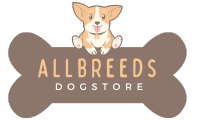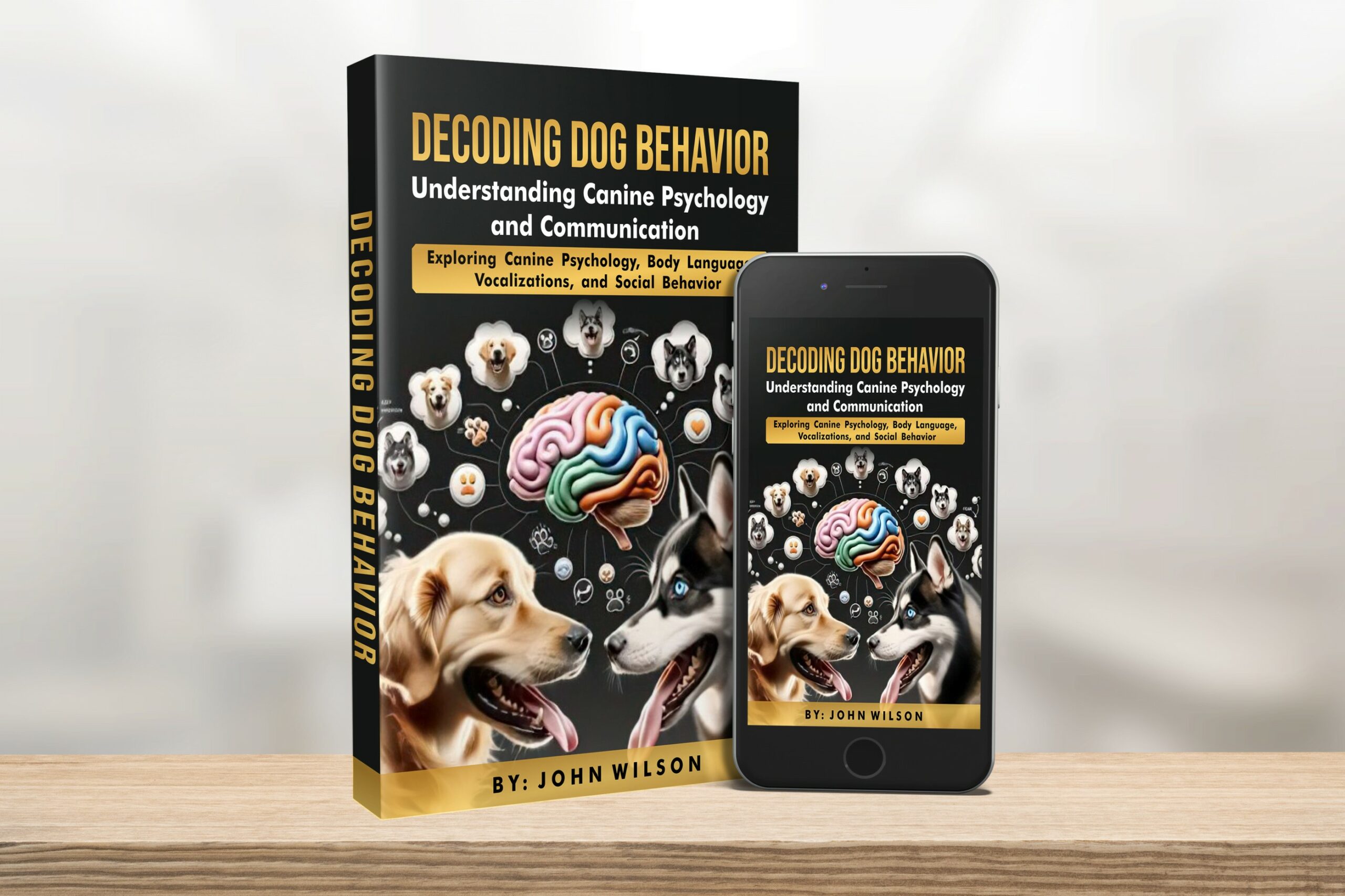EBOOK
EBOOK
Decoding Dog Behavior: Understanding Canine Psychology and Communication
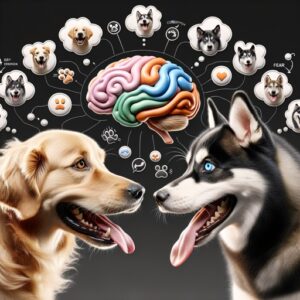
Exploring Canine Psychology, Body Language, Vocalizations, and Social Behavior
By John Wilson

**Chapter 1: Introduction to Understanding Dog Behavior**
Understanding dog behavior is fundamental to building a strong and fulfilling relationship with our canine companions. Dogs, as social animals, communicate primarily through body language, vocalizations, and subtle cues that convey their emotions and intentions. By delving into the basics of canine psychology, we gain valuable insights that can improve our interactions with dogs and address behavioral challenges effectively.
Canine psychology encompasses the study of how dogs think, learn, and perceive the world around them. Dogs possess cognitive abilities that enable them to solve problems, remember experiences, and form emotional attachments with humans and other animals. By understanding their cognitive processes, we can tailor training methods and provide enrichment activities that cater to their intellectual needs.
Interpreting communication cues is another essential aspect of understanding dog behavior. Dogs rely heavily on non-verbal signals to express themselves. Their body postures, facial expressions, tail wagging, and ear positions convey a wealth of information about their mood and state of mind. For instance, a relaxed posture with a wagging tail indicates happiness and friendliness, while a stiff body posture with raised hackles signals fear or aggression.
Moreover, learning about dog behavior enhances our ability to recognize and address behavioral issues effectively. Many common behavioral problems, such as excessive barking, chewing, or aggression, stem from underlying causes that can be traced back to a dog’s emotional state or past experiences. By identifying these triggers and understanding the motivations behind certain behaviors, we can implement positive reinforcement techniques and behavior modification strategies to promote desirable behaviors and discourage unwanted ones.
Beyond behavior modification, understanding dog behavior fosters empathy and compassion towards our four-legged companions. Dogs experience emotions such as joy, fear, sadness, and anxiety much like humans do. Recognizing and validating their emotions allows us to provide appropriate support and create a safe environment that promotes their overall well-being.
Ultimately, the benefits of understanding dog behavior extend beyond basic obedience training. It enriches our relationship with dogs by facilitating clear communication, mutual trust, and a deeper connection based on empathy and respect. As we embark on this journey to explore the intricacies of canine psychology and communication, we equip ourselves with valuable tools to nurture harmonious and fulfilling relationships with our furry friends. In the chapters that follow, we will delve deeper into specific aspects of dog behavior, providing practical insights and strategies for improving our understanding and interactions with dogs of all breeds and personalities.

*Chapter 2: Canine Psychology: How Dogs Think and Learn
Exploring the intricacies of canine psychology unveils the fascinating ways in which dogs think, learn, and navigate their world. Dogs possess remarkable cognitive abilities that enable them to adapt to various situations, solve problems, and form meaningful bonds with humans. By understanding the underlying mechanisms of canine cognition, we can better appreciate and nurture their intelligence.
**Learning Processes in Dogs**
Dogs learn through a combination of classical conditioning, operant conditioning, and observational learning. Classical conditioning involves associating two stimuli, such as pairing a sound (like a clicker) with a reward (like a treat), to elicit a desired response (like sitting). Operant conditioning, on the other hand, relies on rewards and consequences to reinforce or discourage specific behaviors. Dogs also learn by observing and imitating the behaviors of other dogs or humans, a phenomenon known as observational learning.
**Memory and Problem-Solving Skills**
Dogs exhibit impressive memory capabilities, particularly when it comes to associative learning and spatial memory. They can remember past experiences, locations of resources (such as favorite toys or hiding spots), and routines established through consistent training. Dogs also possess problem-solving skills, which are evident in their ability to navigate obstacles, find hidden objects, and strategize to obtain rewards. Puzzle toys and enrichment activities capitalize on dogs’ problem-solving instincts, providing mental stimulation and reinforcing their cognitive abilities.
**Emotional Responses and Social Cognition**
Dogs experience a range of emotions, including joy, fear, sadness, and empathy. They are highly attuned to human emotions and can form strong emotional bonds with their owners. Dogs demonstrate social cognition by interpreting human gestures and facial expressions, such as pointing and smiling, to understand cues and communicate effectively. This social intelligence facilitates cooperation and enhances their ability to interact with humans and other animals.
By appreciating the cognitive abilities of dogs, we can tailor training methods and enrichment activities to optimize their learning experiences and mental well-being. Positive reinforcement techniques leverage dogs’ natural inclination to seek rewards, promoting desired behaviors while strengthening the bond between dogs and their owners. Providing mental challenges and opportunities for problem-solving enriches dogs’ lives and prevents boredom-related behaviors.
In summary, canine psychology encompasses a spectrum of cognitive abilities that shape dogs’ behavior and interactions. Understanding how dogs think, learn, and respond emotionally enables us to nurture their intelligence, enhance their quality of life, and cultivate harmonious relationships built on trust and mutual understanding. As we delve deeper into the realm of canine psychology, we uncover the unique capabilities that make dogs such remarkable companions and lifelong learners.

Chapter 3: Decoding Dog Body Language
Body language serves as a powerful form of communication for dogs, conveying a wealth of information about their emotional state, intentions, and interactions with their environment. By deciphering the nuances of canine body language, we can gain valuable insights into a dog’s mood, comfort level, and readiness to engage in social interactions.
**Postures and Gestures**
A dog’s body posture can reveal a wealth of information about its emotional state and intentions. An alert and confident dog typically stands with a relaxed posture, ears forward, and tail held at a neutral position. Conversely, a dog that feels threatened or fearful may exhibit defensive postures, such as crouching low to the ground, tucking its tail between its legs, or averting its gaze. Understanding these postures can help us assess a dog’s emotional well-being and respond appropriately to their needs.
**Facial Expressions**
Dogs use facial expressions to convey a wide range of emotions, from happiness and excitement to anxiety and apprehension. A relaxed and open mouth with a slightly panting tongue indicates a calm and content dog. Raised eyebrows and wide eyes may signal curiosity or alertness. On the other hand, a tense expression with narrowed eyes and pulled-back lips can indicate discomfort or aggression. Observing these facial cues allows us to gauge a dog’s emotional state and adjust our interactions accordingly.
**Tail Movements**
A dog’s tail is a vital indicator of its emotional state and intentions. A loosely wagging tail, accompanied by a relaxed body posture, indicates friendliness and a willingness to engage. Rapid and stiff tail wagging, often accompanied by a rigid body, can signal excitement or agitation. A tucked tail, held close to the body, suggests fear or submission. Paying attention to the nuances of tail movements helps us interpret a dog’s mood and respond with empathy and understanding.
**Ear Positions**
The position and movement of a dog’s ears also convey important information about its mood and level of arousal. Forward-facing ears typically indicate attentiveness and interest, while flattened ears against the head can signal fear, anxiety, or aggression. Dogs may also rotate their ears to focus on specific sounds or stimuli in their environment. By observing ear positions, we can assess a dog’s emotional state and tailor our interactions to promote a sense of security and comfort.
By honing our ability to decode dog body language, we can cultivate stronger bonds with our canine companions and ensure positive social interactions. Recognizing and respecting a dog’s communication cues fosters trust and mutual understanding, facilitating harmonious relationships built on empathy and clear communication. As we deepen our understanding of dog body language, we enrich our ability to interpret and respond to their needs, ultimately strengthening the human-canine bond.

Chapter 4: Interpreting Dog Vocalizations
Dogs rely on vocalizations as a fundamental means of communication, using a diverse range of sounds to convey emotions, intentions, and responses to their environment. By understanding and interpreting these vocal cues, we can gain valuable insights into a dog’s state of mind and effectively respond to their needs.
**Types of Vocalizations**
Dogs produce a variety of vocalizations, each serving distinct purposes and carrying specific meanings:
1. **Barks**: Perhaps the most common vocalization, barking can signify different emotions and messages depending on its tone, pitch, and frequency. A sharp, repetitive bark may indicate alertness or excitement, while a low, prolonged bark can signal warning or aggression. Dogs may also use short, rapid barks to express playfulness or anticipation.
2. **Growls**: Growling is a form of vocalization often associated with threat or defense. However, dogs can growl for various reasons, including playfulness, frustration, or discomfort. The intensity and duration of the growl, coupled with accompanying body language, provide crucial context for interpreting its meaning.
3. **Whines and Whimpers**: Whining and whimpering are softer vocalizations typically associated with soliciting attention, expressing anxiety, or seeking comfort. Dogs may whine when anticipating food, greeting their owners, or experiencing mild distress. Prolonged or persistent whining may indicate underlying discomfort or stress.
4. **Howls**: Howling is a distinctive vocalization used by dogs to communicate over long distances or in response to specific stimuli, such as sirens or other dogs’ howls. Howling can convey loneliness, territoriality, or excitement and serves as a means of vocalizing in communal settings.
**Interpreting Vocal Cues**
To accurately interpret dog vocalizations, it’s essential to consider the following factors:
– **Context**: The context in which vocalizations occur provides vital clues to their meaning. Is the dog barking while greeting a visitor, during play, or in response to perceived threats? Understanding the surrounding circumstances helps decipher the underlying message.
– **Body Language**: Vocalizations are often accompanied by specific body postures and facial expressions. Observing a dog’s stance, tail position, ear movements, and overall demeanor enhances our understanding of their emotional state and intentions.
– **Consistency and Intensity**: The consistency, frequency, and intensity of vocalizations offer insights into a dog’s emotional arousal level. Persistent, escalating vocalizations may indicate discomfort, frustration, or excitement requiring attention.
– **Individual Variations**: Dogs exhibit unique vocalization patterns based on breed, personality, and past experiences. Familiarizing oneself with a dog’s typical vocal repertoire facilitates accurate interpretation and effective communication.
By honing our ability to interpret dog vocalizations, we establish clearer lines of communication with our canine companions and foster harmonious relationships. Responding thoughtfully and empathetically to their vocal cues strengthens mutual trust and understanding, enriching the human-canine bond. As we cultivate sensitivity to dog vocalizations, we enhance our capacity to meet their emotional and social needs, promoting a fulfilling and supportive companionship.
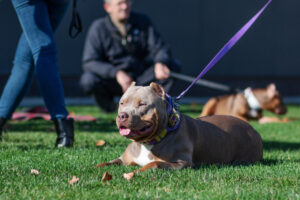
Chapter 5: Social Behavior in Dogs
Dogs are naturally social beings, with social behavior deeply ingrained in their evolutionary history and domesticated nature. Understanding how dogs interact with each other and with humans provides valuable insights into their social dynamics, hierarchy, and communication methods.
**Pack Dynamics**
Historically, dogs descended from pack animals, relying on cooperative group behavior for survival. While domestication has altered some aspects of their social structure, dogs still exhibit pack-like behaviors. Packs are characterized by hierarchical structures, where individuals establish roles and relationships based on dominance and submission.
In domestic settings, dogs often form social groups with other dogs they encounter regularly, such as those in the same household or neighborhood. Pack dynamics influence how dogs communicate, play, and establish relationships within their social circle.
**Social Hierarchy**
Within a dog pack, a social hierarchy determines the order of dominance and submission among members. Dominance hierarchy is established through body language, vocalizations, and physical interactions. Alpha dogs typically occupy leadership roles, influencing group activities and interactions.
Understanding social hierarchy is crucial for managing multiple dogs in a household and preventing conflicts. Recognizing signs of dominance or submission helps owners foster harmonious relationships and discourage aggressive behavior.
**Play Behavior**
Play is an essential component of social behavior in dogs, serving various purposes such as social bonding, learning, and communication. Play behavior involves specific postures, gestures, and vocalizations that convey playfulness and engagement. Dogs use play to practice social skills, establish boundaries, and relieve stress.
Observing play interactions can provide insights into dogs’ relationships and preferences. Play styles vary between individuals, with some dogs preferring rough-and-tumble play while others engage in gentler interactions. Monitoring play behavior facilitates positive socialization and strengthens social bonds.
**Territorial Instincts**
Dogs exhibit territorial behavior to protect resources, establish boundaries, and communicate ownership. Territorial instincts manifest through scent marking, vocalizations, and defensive postures aimed at deterring intruders. Understanding territorial behavior helps owners manage issues related to territory, such as aggression towards unfamiliar dogs or people encroaching on perceived space.
**Interacting with Humans**
Dogs’ social behavior extends to interactions with humans, whom they perceive as members of their social group. Dogs communicate with humans through body language, vocalizations, and learned behaviors to convey needs, emotions, and desires. Positive human-dog interactions strengthen the human-canine bond and promote mutual understanding.
By comprehending social behavior in dogs, owners can foster positive social interactions, prevent conflicts, and promote emotional well-being. Recognizing dogs’ innate social instincts enhances our ability to meet their social needs and provide enriching experiences that support their overall health and happiness. Applying principles of canine social behavior strengthens relationships and facilitates effective communication, benefiting both dogs and their human companions.

Chapter 6: The Development of Canine Behavior
Understanding the development of canine behavior is essential for comprehending the factors that shape a dog’s personality, temperament, and social skills. Dogs undergo distinct stages of development from birth to adulthood, with each phase influencing their behavioral tendencies and responses to the environment.
**Puppyhood: Early Socialization and Learning**
The initial weeks of a puppy’s life are critical for social and cognitive development. During this sensitive period, puppies rely on interactions with littermates, their mother, and humans to learn social skills and establish bonds. Puppies begin exploring their surroundings, learning basic motor skills, and developing preferences for certain stimuli.
Early socialization plays a pivotal role in shaping a puppy’s behavior and temperament. Exposure to various people, animals, objects, and environments during this period promotes adaptability and reduces fear of novel experiences. Positive interactions lay the foundation for future social behavior and emotional resilience.
**Juvenile Stage: Learning Through Play and Exploration**
As puppies transition into juveniles, typically between 3 to 6 months of age, they become more active and independent. Play behavior intensifies, serving as a means of learning social cues, practicing communication, and refining motor skills. Juveniles engage in exploratory behaviors, investigating their surroundings and testing boundaries.
Training and guidance during the juvenile stage are crucial for establishing desirable behaviors and preventing problematic habits. Positive reinforcement techniques, such as reward-based training, facilitate learning and promote cooperation. Consistent routines and clear boundaries contribute to behavioral stability and confidence.
**Adolescence: Behavioral Challenges and Maturation**
The adolescent stage, spanning from 6 to 18 months, is characterized by physical growth and hormonal changes. Dogs may exhibit behavioral challenges, such as increased independence, testing authority, and heightened energy levels. Adolescents require patient guidance and structured training to navigate this transitional phase successfully.
Behavioral issues, such as aggression, fearfulness, or excessive energy, can emerge during adolescence. Understanding normal adolescent behaviors and addressing specific needs, such as mental stimulation and physical exercise, helps mitigate potential challenges. Positive reinforcement, socialization, and consistency promote positive behavioral development.
**Adulthood: Behavior Stability and Lifelong Learning**
By adulthood, typically around 1 to 3 years of age, dogs reach behavioral maturity, displaying stability in temperament and behavior. Adult dogs continue to learn and adapt to their environment, requiring ongoing mental stimulation and social interaction. Lifelong learning opportunities, such as training classes or enrichment activities, support cognitive function and prevent boredom.
The development of canine behavior is influenced by genetic predispositions, early experiences, and ongoing learning throughout life. Understanding developmental stages enables owners to address behavioral issues proactively, promote healthy socialization, and foster a strong bond with their canine companions. By supporting optimal development, owners contribute to their dogs’ overall well-being and happiness.

Chapter 7: Factors Influencing Dog Behavior
Understanding the myriad factors that influence a dog’s behavior is crucial for providing appropriate care, training, and support. Dogs exhibit unique behaviors shaped by a combination of genetic predispositions, environmental influences, health considerations, and past experiences. By exploring these factors, we gain insight into the complexities of canine behavior and learn how to promote positive outcomes for our canine companions.
**Genetics and Breed Traits**
Genetics play a significant role in determining a dog’s temperament, instincts, and behavioral tendencies. Different breeds are bred for specific purposes, resulting in distinct traits and behaviors. For example, herding breeds may display strong chasing instincts, while terriers are known for their persistence and tenacity. Understanding breed-specific traits helps owners anticipate behavioral characteristics and tailor training approaches accordingly.
**Early Experiences and Socialization**
A dog’s early experiences, especially during critical developmental periods, profoundly impact their behavior later in life. Adequate socialization during puppyhood—exposure to various people, animals, environments, and stimuli—promotes confidence and reduces fearfulness. Conversely, negative experiences, such as trauma or inadequate socialization, can lead to behavioral challenges, including anxiety or aggression.
**Training and Learning Environment**
The training methods and learning environment significantly influence a dog’s behavior and responsiveness to commands. Positive reinforcement techniques, such as reward-based training, promote cooperation and build trust between dogs and their owners. Conversely, punitive training methods can contribute to fear, anxiety, and avoidance behaviors. Consistency, patience, and clear communication enhance training outcomes and support desirable behavior.
**Living Conditions and Environmental Enrichment**
The physical environment in which a dog lives impacts their behavior and well-being. Adequate exercise, mental stimulation, and enrichment activities are essential for preventing boredom and promoting mental health. Dogs require opportunities for physical exercise, interactive play, and environmental exploration to satisfy their natural instincts and prevent undesirable behaviors stemming from frustration or pent-up energy.
**Health and Medical Considerations**
Underlying health conditions and medical issues can influence a dog’s behavior and mood. Pain, discomfort, or illness may manifest as changes in behavior, including irritability, decreased activity, or reluctance to engage in previously enjoyed activities. Regular veterinary care, preventive measures, and prompt treatment of health issues are essential for maintaining optimal behavioral health and overall well-being.
**Past Experiences and Trauma**
Previous experiences, such as neglect, abuse, or trauma, can profoundly impact a dog’s behavior and emotional resilience. Dogs with traumatic backgrounds may exhibit fear, mistrust, or defensive behaviors. Patient rehabilitation, positive reinforcement, and gradual desensitization can help dogs overcome past trauma and develop confidence and trust in their environment.
Recognizing and addressing the various factors influencing dog behavior empower owners to make informed decisions about training, socialization, and environmental management. By considering these influences holistically, we create supportive environments that foster positive behavior and strengthen the bond between dogs and their caregivers.

Chapter 8: Common Behavior Issues and Solutions
Behavioral issues can significantly impact a dog’s quality of life and strain the bond between owners and their pets. Understanding the underlying causes of common behavior problems is essential for implementing effective solutions and promoting positive behavior.
**Aggression**
Aggression is a complex behavior that can result from fear, territoriality, resource guarding, or past experiences. It’s crucial to identify the triggers and context of aggression to develop a targeted behavior modification plan. Positive reinforcement techniques, desensitization, and counter-conditioning can help modify aggressive responses and promote calm behavior.
**Fearfulness**
Fearful behavior in dogs may stem from genetics, lack of socialization, or traumatic experiences. Dogs exhibiting fear may display avoidance, trembling, or defensive postures. Building confidence through gradual exposure to fear-inducing stimuli, positive reinforcement, and reward-based training can help dogs overcome fearfulness and develop resilience.
**Separation Anxiety**
Separation anxiety is characterized by distress and undesirable behaviors when left alone. Dogs with separation anxiety may exhibit excessive vocalization, destructive behavior, or house soiling. Creating a predictable routine, using gradual desensitization techniques, and providing enrichment activities can alleviate separation anxiety and promote independence.
**Compulsive Behaviors**
Compulsive behaviors, such as tail chasing, excessive licking, or pacing, can result from genetic predispositions, stress, or boredom. Identifying triggers and redirecting compulsive behaviors through mental and physical stimulation, structured activities, and behavior modification exercises can reduce compulsive tendencies and promote relaxation.
**Resource Guarding**
Resource guarding involves the protection of valuable items, such as food, toys, or resting spots. Dogs may display growling, snapping, or defensive behaviors when approached near resources. Teaching alternative behaviors, implementing management strategies (e.g., controlled access to resources), and using positive reinforcement techniques can reduce resource guarding and promote sharing behavior.
**Prevention and Modification Strategies**
Preventing behavior issues through early socialization, positive reinforcement training, and providing appropriate outlets for mental and physical exercise is key to fostering well-adjusted dogs. When addressing existing behavior problems, consistency, patience, and positive reinforcement are essential for achieving lasting behavior change.
**Professional Support**
Seeking guidance from certified trainers, veterinary behaviorists, or animal behavior consultants is recommended for complex behavior issues or persistent challenges. Professional support can provide tailored behavior modification plans, personalized training techniques, and comprehensive support for both dogs and their owners.
By addressing common behavior issues with compassion, patience, and positive training methods, owners can enhance their dogs’ well-being and strengthen their relationship. Implementing proactive prevention strategies and seeking professional guidance when needed empower owners to navigate behavior challenges effectively and promote harmonious interactions with their canine companions.

Chapter 9: Enhancing Communication with Your Dog
Establishing clear and effective communication with your dog is essential for building trust, promoting obedience, and strengthening your bond. Dogs rely on a combination of verbal cues, body language, and training commands to interpret human communication. By mastering these techniques and emphasizing consistency and empathy, you can enhance mutual understanding and deepen your relationship with your canine companion.
**Voice Cues and Tone**
Dogs are highly attuned to the tone and cadence of human voices. Using a calm and encouraging tone during training sessions and interactions reinforces positive behaviors and encourages responsiveness. Consistency in vocal cues, such as using specific words for commands (e.g., “sit,” “stay,” “come”), helps dogs associate vocal cues with desired actions.
**Body Language**
Body language plays a significant role in dog communication. Dogs interpret human body postures, facial expressions, and gestures to understand intentions and emotions. Using open and relaxed body language conveys approachability and reassurance, while tense or abrupt movements may cause confusion or anxiety.
**Training Commands**
Consistent training commands facilitate effective communication between dogs and their owners. Establishing clear and concise commands for basic obedience tasks (e.g., sit, stay, heel) and using positive reinforcement techniques (e.g., treats, praise) reinforce desired behaviors and encourage compliance. Repetition and consistency are key to ingraining commands and fostering obedience.
**Non-verbal Cues**
In addition to vocal cues, dogs respond to non-verbal cues, such as hand signals or gestures. Associating specific gestures with commands (e.g., raising a hand for “stay”) enhances communication, particularly in noisy or distracting environments where verbal cues may be less effective.
**Consistency and Patience**
Consistency is paramount in dog training and communication. Using consistent commands, cues, and reinforcement methods establishes predictable expectations and reinforces learning. Patience is essential when communicating with dogs, especially during training sessions or when addressing behavioral challenges. Remaining patient and calm promotes positive interactions and encourages cooperation.
**Empathy and Understanding**
Empathy fosters a deeper connection between dogs and their owners. Understanding and responding to a dog’s emotional cues and individual personality traits promote trust and mutual respect. Recognizing and accommodating a dog’s needs and preferences strengthens the human-dog bond and encourages responsive communication.
**Building Trust and Rapport**
Effective communication builds trust and rapport over time. Consistent training, positive reinforcement, and empathetic interactions demonstrate respect and understanding, fostering a harmonious relationship based on mutual cooperation and companionship.
By incorporating clear vocal cues, supportive body language, consistent training methods, and empathetic understanding, you can enhance communication with your dog and strengthen your relationship. Practicing patience, consistency, and empathy promotes positive interactions and reinforces mutual understanding, ultimately deepening the bond between you and your canine companion.

Chapter 10: Building a Strong Bond Through Understanding
Understanding dog behavior is the foundation for building a strong and lasting bond with your canine companion. By applying the knowledge gained from this ebook, readers can deepen their connection with their dogs and create enriching experiences that strengthen the human-canine relationship.
**Embracing Empathy and Respect**
Empathy plays a crucial role in nurturing a strong bond with your dog. By understanding and empathizing with your dog’s emotions, needs, and behaviors, you demonstrate compassion and build trust. Respect for your dog’s individuality and unique personality fosters mutual respect and strengthens the bond.
**Developing Trust and Communication**
Trust is essential for a positive relationship with your dog. By communicating effectively and consistently, using clear cues and positive reinforcement, you establish trust and encourage cooperation. Consistency in training and interactions builds confidence and reliability in your relationship.
**Creating Enriching Experiences**
Understanding your dog’s behavior allows you to create enriching experiences that cater to their physical, mental, and emotional needs. Engage in activities that align with your dog’s preferences and interests, such as interactive play, training sessions, or outdoor adventures. Tailoring experiences to your dog’s personality strengthens the bond and promotes mutual enjoyment.
**Promoting Positive Interactions**
Positive interactions are fundamental to a strong bond. Use reward-based training methods and encourage desirable behaviors to reinforce positive interactions. Avoid punishment-based techniques that can damage trust and undermine the relationship.
**Fostering Mutual Understanding**
Deepen your bond by fostering mutual understanding and communication. Learn to interpret your dog’s body language, vocalizations, and behavioral cues to better understand their needs and emotions. Respond appropriately to your dog’s signals and adapt your interactions accordingly.
**Building Consistency and Routine**
Consistency and routine provide structure and predictability for your dog, promoting security and confidence. Establish consistent training methods, daily routines, and boundaries to create a stable environment that supports your dog’s well-being and strengthens the bond.
**Enjoying Quality Time Together**
Spending quality time with your dog strengthens the bond and creates cherished memories. Engage in activities that nurture connection and reinforce positive behaviors, such as walks, training sessions, or relaxing cuddle time. Make time for bonding activities that strengthen your relationship.
**Celebrating Achievements and Milestones**
Acknowledge and celebrate your dog’s achievements and milestones. Recognize progress in training, behavior, or health goals with praise, rewards, and affection. Positive reinforcement reinforces desired behaviors and strengthens the bond between you and your dog.
**Embracing the Journey**
Building a strong bond with your dog is a rewarding journey that requires patience, dedication, and understanding. Embrace the process of learning and growing together, celebrating the unique bond you share. By applying the principles of empathy, respect, and trust, you create a harmonious relationship built on mutual love and companionship.
In conclusion, by applying the principles of empathy, respect, and trust, readers can deepen their bond with their dogs and create meaningful experiences that strengthen the human-canine relationship. Understanding dog behavior and responding with empathy and consistency fosters trust, communication, and mutual understanding, ultimately creating a harmonious and enriching bond between you and your beloved companion
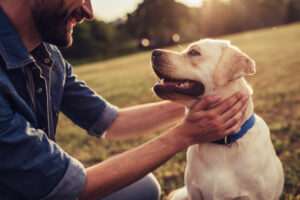
.In conclusion
, “Decoding Dog Behavior” provides a comprehensive guide to understanding canine psychology and communication. By exploring the intricacies of dog behavior, readers can develop a deeper appreciation for their furry companions and enhance their ability to communicate effectively. Understanding dog behavior is not only essential for addressing behavioral issues but also for cultivating a fulfilling and harmonious relationship with dogs.
–
